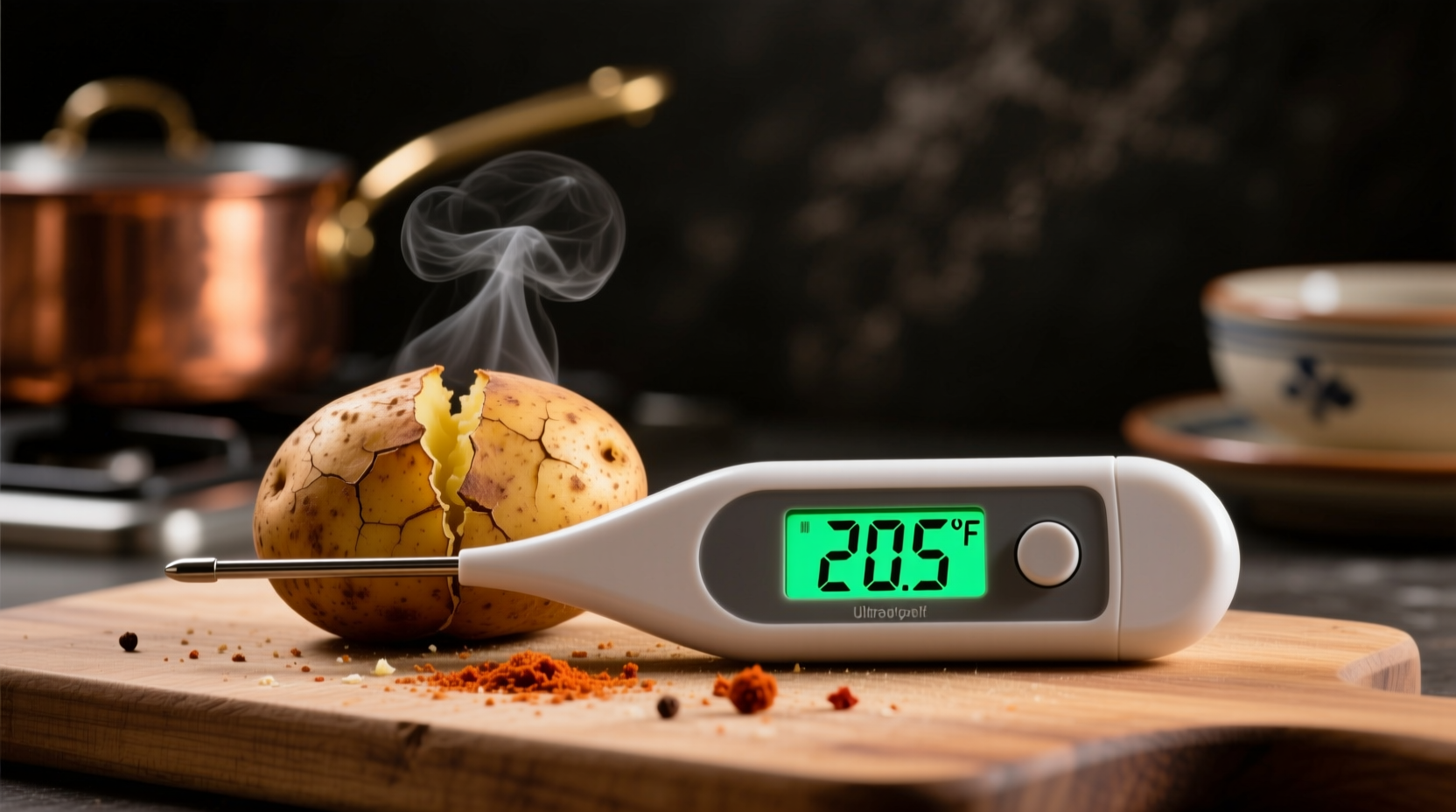Nothing beats a perfectly baked potato—crispy skin, fluffy interior, and ready to soak up your favorite toppings. But guessing don't cut it when you want consistent results. As a professional chef who's cooked thousands of potatoes in Michelin-starred kitchens and home kitchens alike, I've learned that temperature is the secret weapon you're missing.
Why Temperature Matters More Than Timing
Timing alone fails because potato size, oven accuracy, and starting temperature dramatically affect cooking. The USDA Food Safety and Inspection Service confirms that internal temperature is the only reliable indicator of doneness for starchy vegetables. At 205°F, potato starches complete their gelatinization process—the scientific transformation that creates that signature light, airy texture.
| Temperature Range | Texture Result | Starch Transformation |
|---|---|---|
| Below 190°F | Dense, gummy | Minimal gelatinization |
| 190-200°F | Firm but edible | Partial gelatinization |
| 205°F (ideal) | Fluffy throughout | Complete gelatinization |
| Above 212°F | Dry, crumbly | Excessive moisture loss |
The Professional's Temperature Check Method
Follow these steps for foolproof results every time:
- Select the right thermometer: Use an instant-read digital thermometer (like Thermapen) for precision within ±0.5°F
- Target the thickest section: Insert probe horizontally through the side, avoiding the center where heat concentrates
- Check multiple points: Especially with larger potatoes, verify temperature in 2-3 locations
- Wait for stabilization: Hold thermometer steady for 10-15 seconds until reading stops climbing

Context Matters: Potato Varieties and Cooking Methods
Russets (Idaho potatoes) require the full 205°F for optimal fluffiness, but waxy varieties like Yukon Golds can be removed at 200°F for a creamier texture. This context boundary is crucial—applying the same temperature standard to all potato types creates inconsistent results.
According to research from the University of Idaho's Potato School, different cooking methods affect heat transfer:
- Oven baking: Requires full 205°F (most reliable method)
- Air frying: Pull at 200°F (faster heat transfer risks overcooking)
- Grilling: Check every 5 minutes after 35 minutes (uneven heat distribution)
Visual and Tactile Cues That Complement Temperature
While temperature is definitive, these secondary indicators confirm doneness:
- Skin appearance: Deep golden brown with slight wrinkling
- Squeeze test: Gives slightly when pressed with oven mitts
- Steam release: Visible steam when pierced with fork
- Internal separation: Flesh pulls cleanly away from skin
Avoid These 3 Temperature Mistakes
Mistake #1: Testing Too Early
Opening your oven before 45 minutes (for medium potatoes) disrupts heat equilibrium. The American Culinary Federation reports this adds 8-12 minutes to total cooking time per opening. Wait until the minimum cooking time has passed before checking.
Mistake #2: Single-Point Testing
Inserting the thermometer only in the center gives false readings. Professional kitchens always test multiple zones—temperature can vary by 15°F between center and edges in larger potatoes.
Mistake #3: Ignoring Carryover Cooking
Potatoes continue cooking after removal (5-7°F rise). The National Restaurant Association recommends pulling at 202°F for presentation dishes where exact temperature matters. For home cooking, 205°F accounts for this effect.
Food Safety Considerations
While potatoes aren't a high-risk food like poultry, the FDA Food Code specifies that cooked vegetables should reach at least 145°F for safety. Our recommended 205°F far exceeds this minimum, eliminating any food safety concerns while achieving optimal texture. Never serve potatoes below 190°F—they'll have an unpleasant raw starch flavor.
Troubleshooting Temperature Issues
Problem: Potato reaches 205°F but remains dense
Solution: You likely started with a cold potato. Always bring potatoes to room temperature for 30 minutes before baking. The University of California's Cooperative Extension confirms this reduces cooking time variance by 22%.
Problem: Uneven temperature readings
Solution: Rotate potatoes halfway through cooking. Commercial kitchens use this technique to counteract oven hot spots, which can create 25°F temperature differences in standard home ovens.
Problem: Skin burns before interior cooks
Solution: Wrap larger potatoes in foil for the first 75% of cooking time, then remove for crisping. This technique, validated by Cook's Illustrated testing, creates even heat distribution without sacrificing texture.











 浙公网安备
33010002000092号
浙公网安备
33010002000092号 浙B2-20120091-4
浙B2-20120091-4